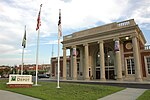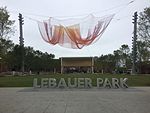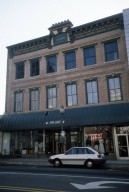Lyndon Street Townhouses
1905 establishments in North CarolinaColonial Revival architecture in North CarolinaGuilford County, North Carolina Registered Historic Place stubsHouses completed in 1905Houses in Greensboro, North Carolina ... and 3 more
Houses on the National Register of Historic Places in North CarolinaNational Register of Historic Places in Guilford County, North CarolinaQueen Anne architecture in North Carolina

Lyndon Street Townhouses are four historic rowhouses located at Greensboro, Guilford County, North Carolina, US. They were built in about 1905, and are two-story, three-bay, brick structures with Colonial Revival and Queen Anne style design elements. Each house has a polygonal bay window at the second story. The houses are united by a porch spanning their full width, supported by seven Doric order columns raised on tall brick piers.The row was listed on the National Register of Historic Places in 1992.
Excerpt from the Wikipedia article Lyndon Street Townhouses (License: CC BY-SA 3.0, Authors, Images).Lyndon Street Townhouses
South Lyndon Street, Greensboro
Geographical coordinates (GPS) Address Nearby Places Show on map
Geographical coordinates (GPS)
| Latitude | Longitude |
|---|---|
| N 36.071111111111 ° | E -79.785277777778 ° |
Address
South Lyndon Street 219
27401 Greensboro
North Carolina, United States
Open on Google Maps








